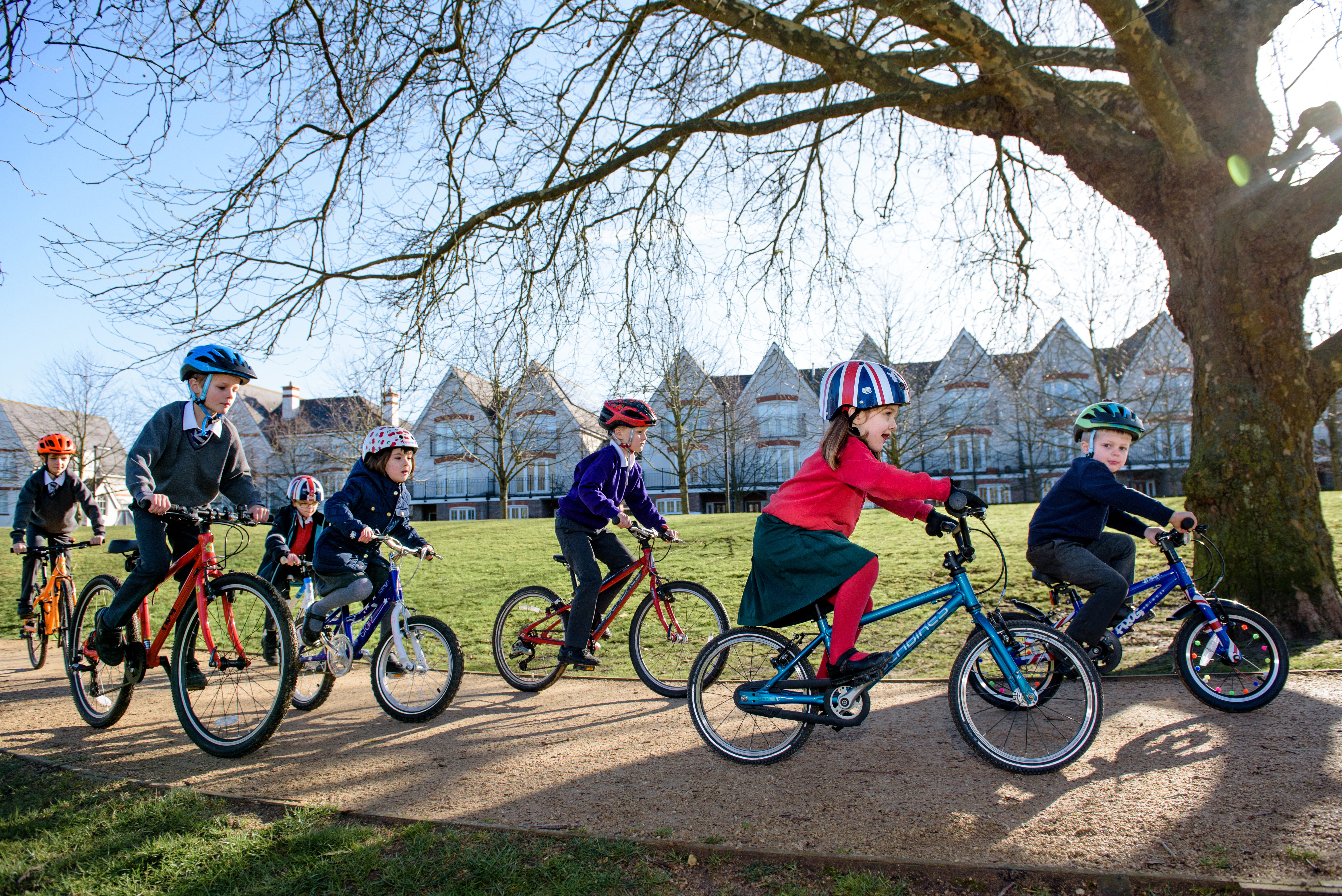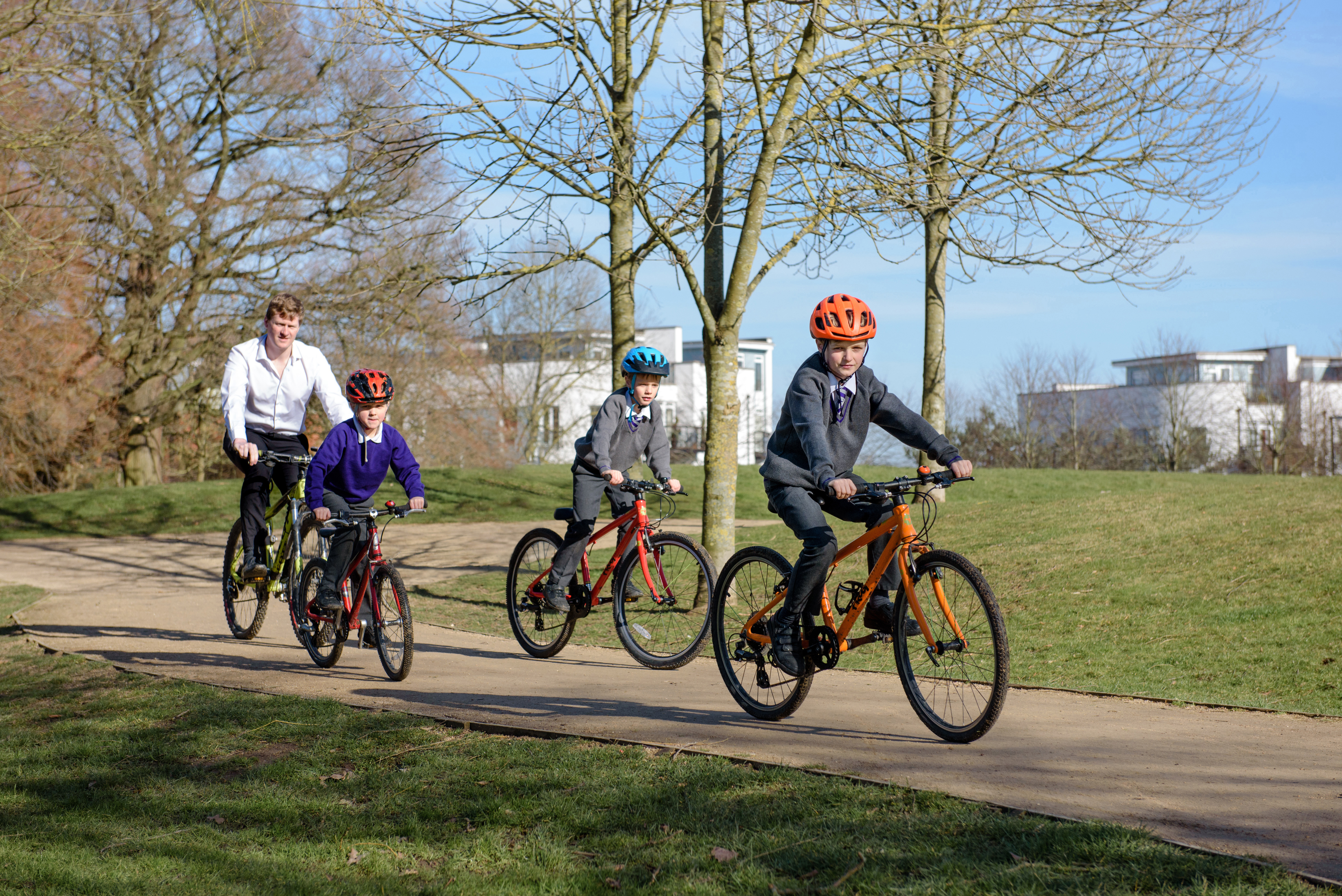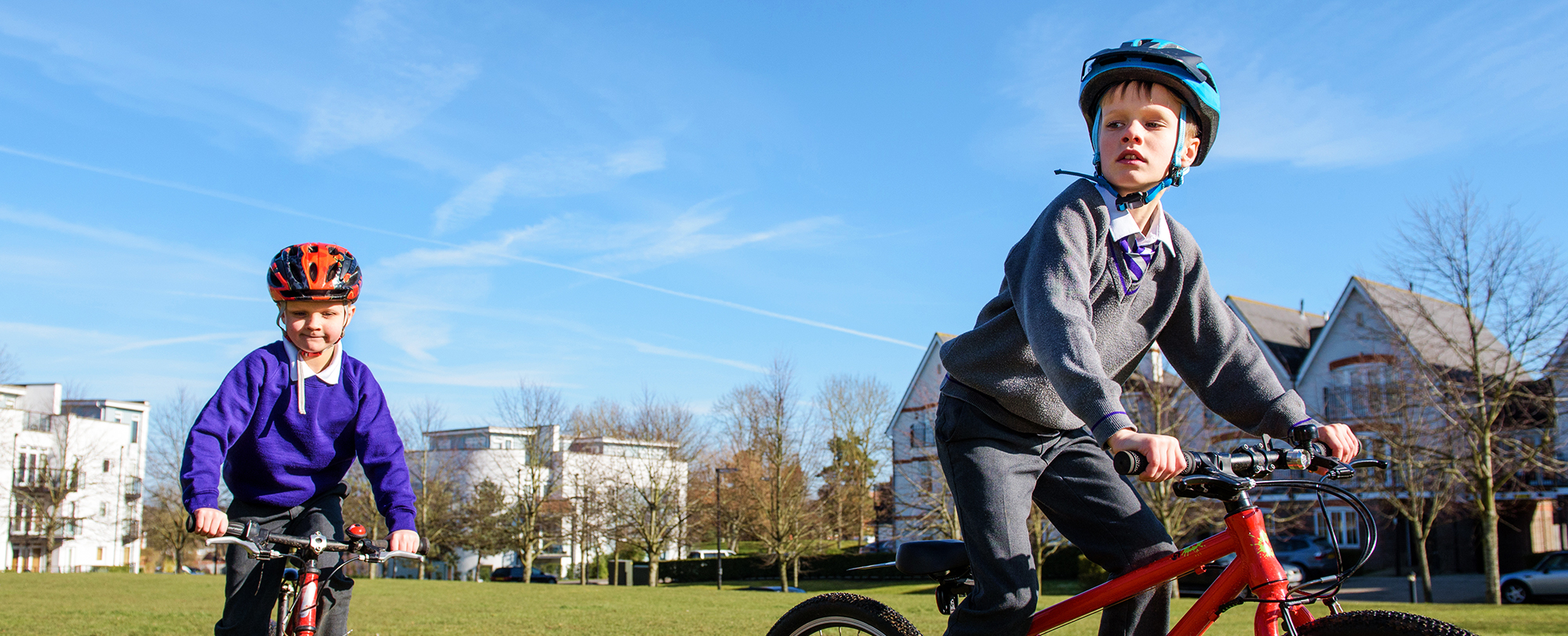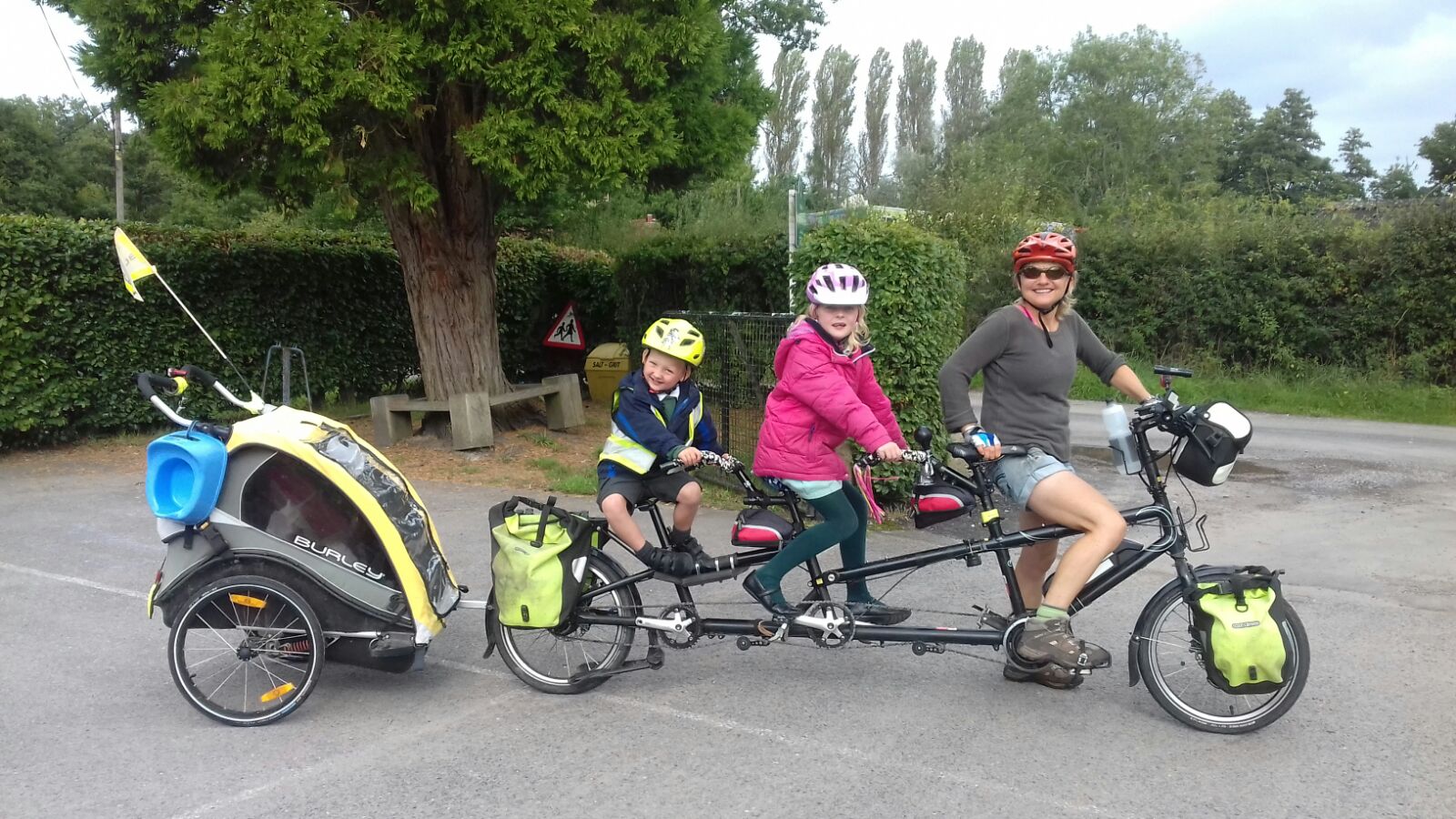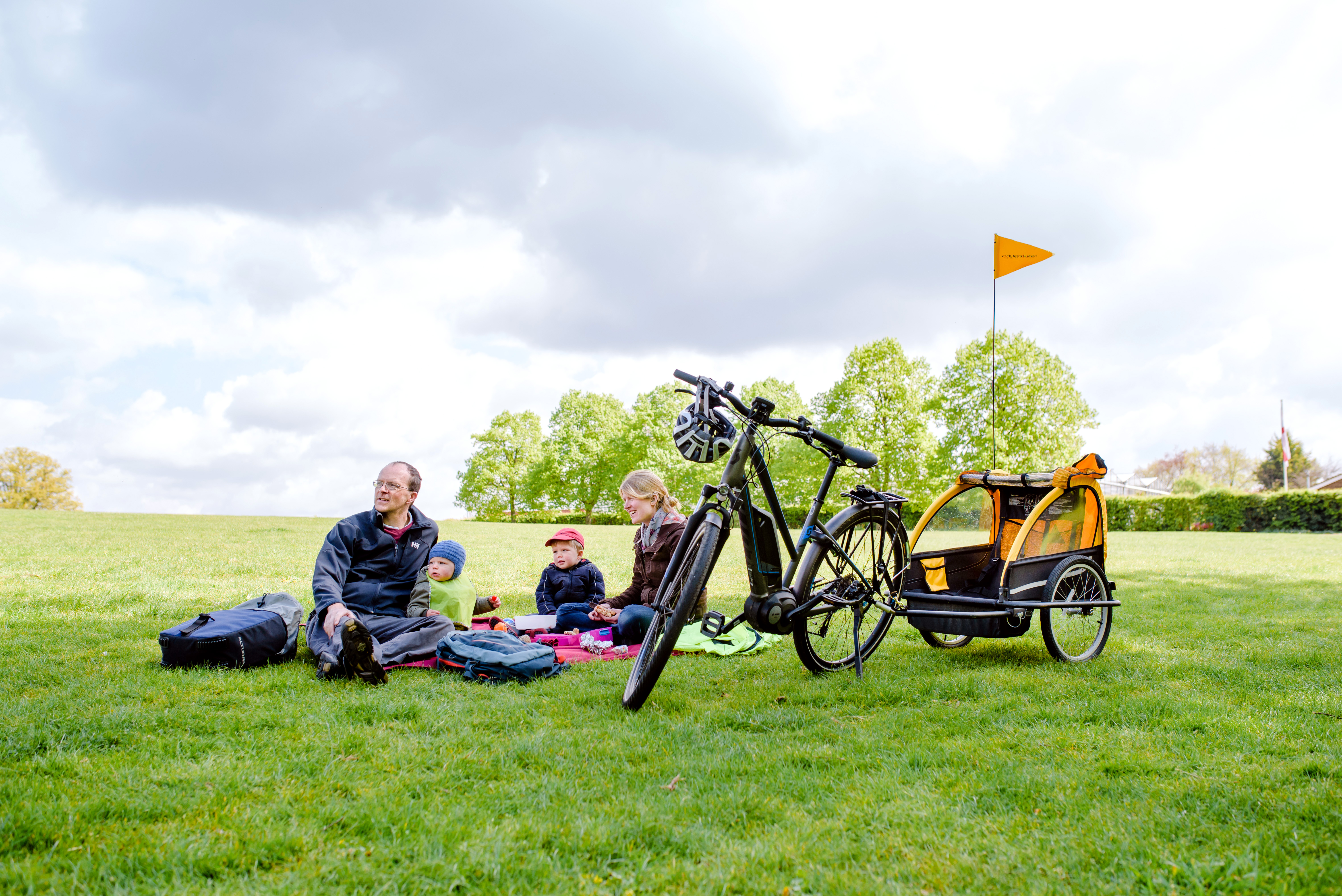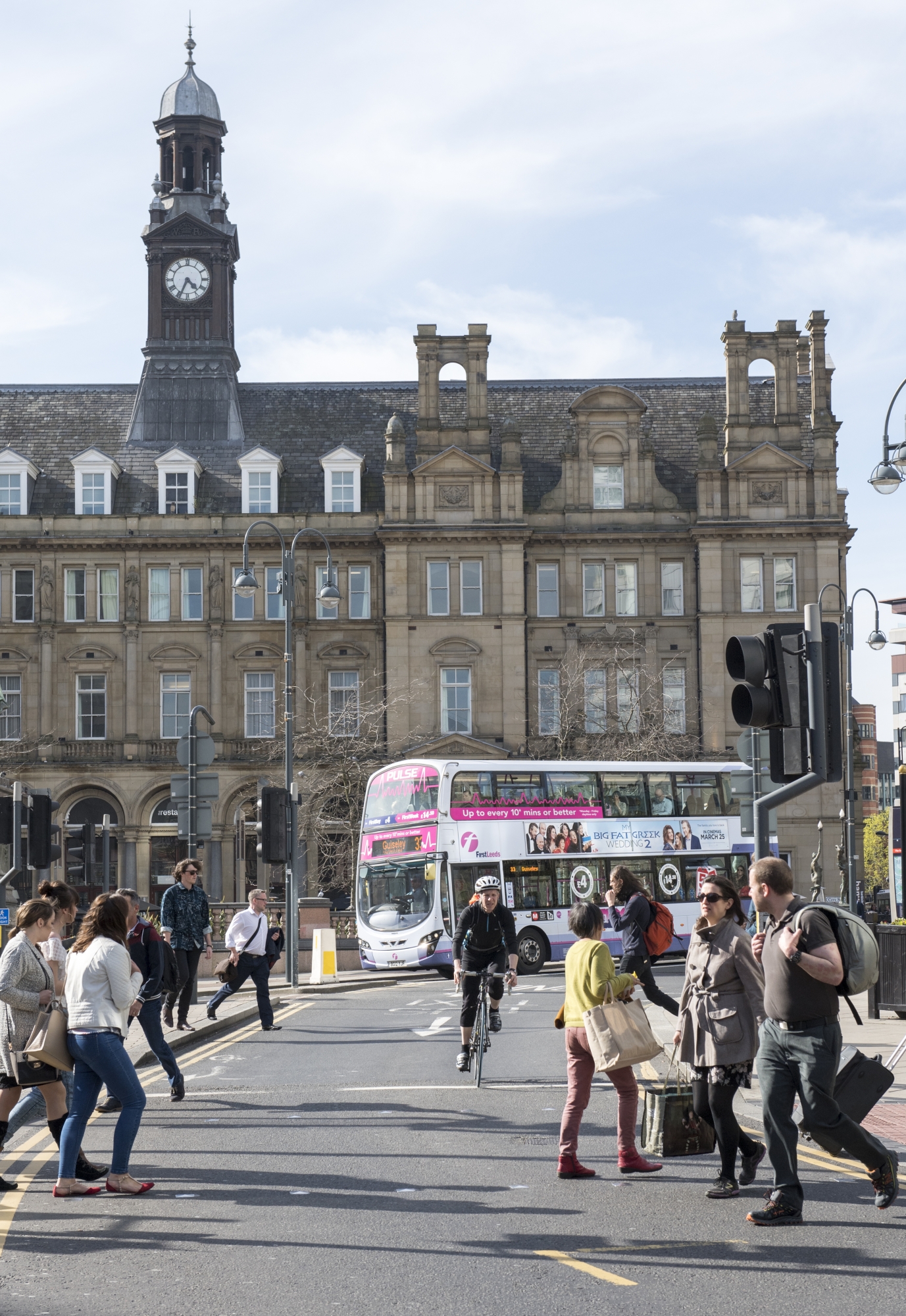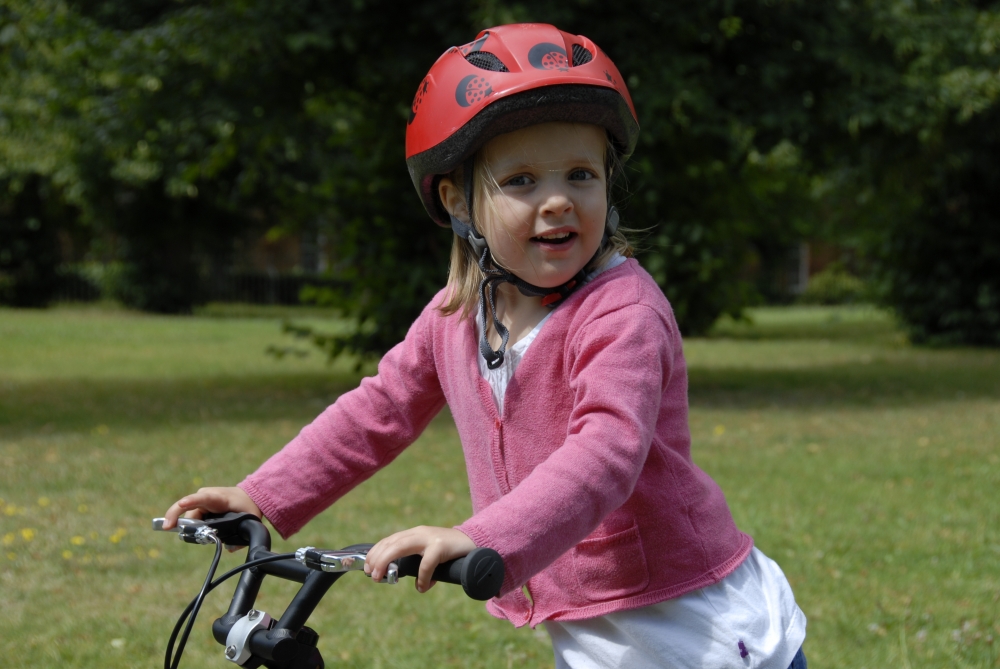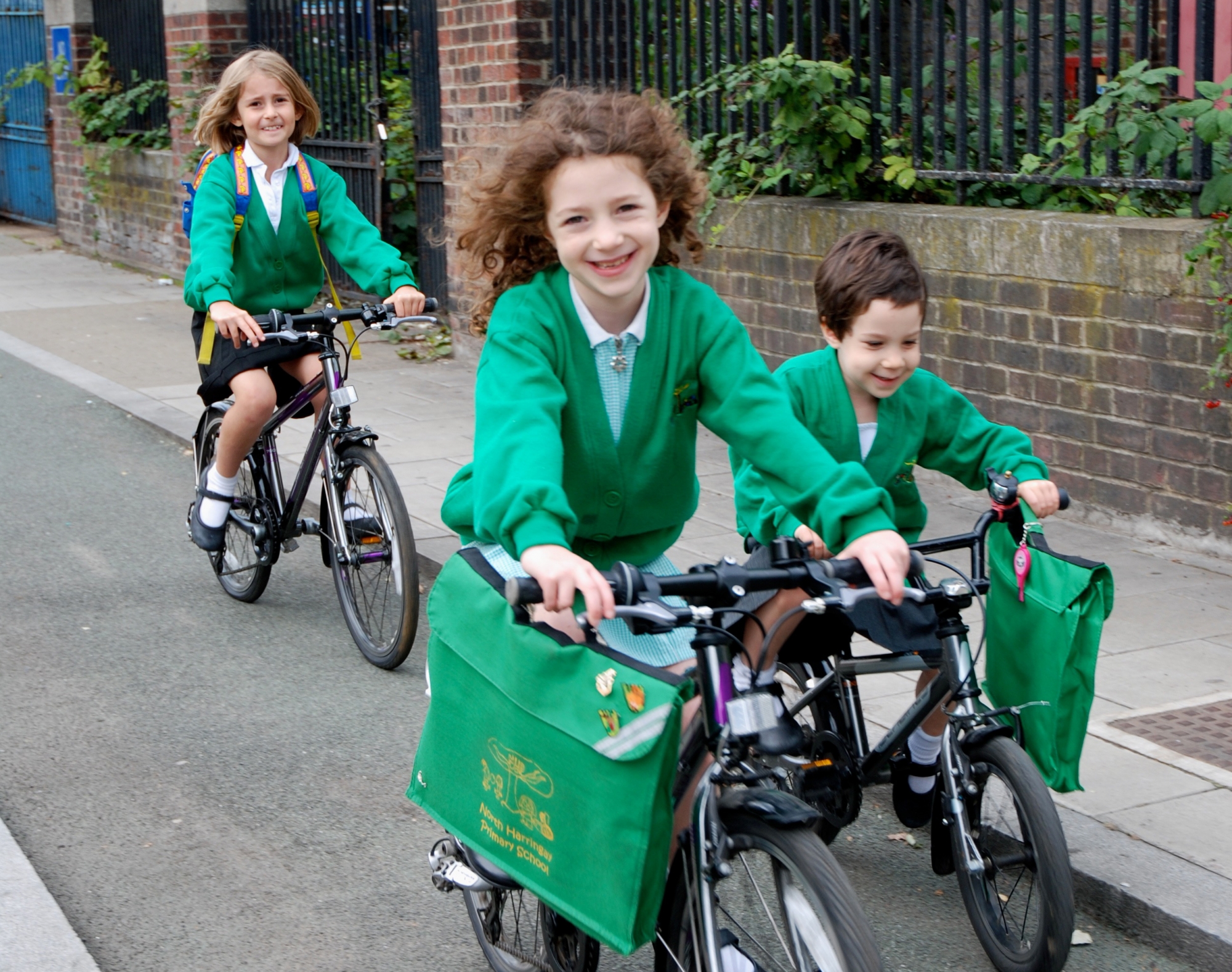How to convert schools to cycling
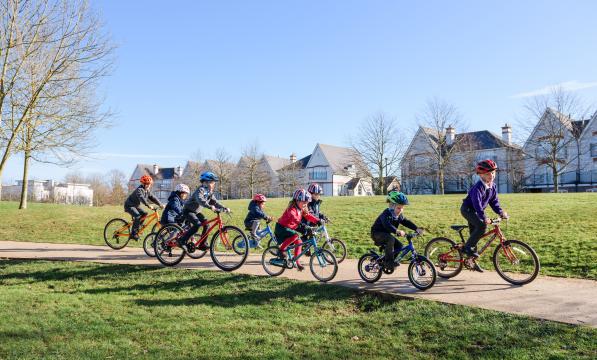
Is your child’s school discouraging cycling or banning it altogether? Do you want to do something about it? This guide will help, we hope. It’s mainly for parents, but should also be useful for teachers, heads, governors, councils and anyone who organises after-school programmes.
Important! Although many of the actions suggested below need to be initiated by adults, we strongly encourage everyone to work closely with the child(ren) involved at every step of the way. After all, the issue is essentially about them.
Why encourage children to cycle for the school run?
Cycling UK believes that all schools should welcome children (plus parents and staff) who want to cycle there. Why?
- Cycling doubles up as useful transport and exercise, helping children (and adults) meet NHS physical activity guidelines and maintain a healthy weight. Figures on unhealthy weight among children are alarming: in England, over a fifth of those in Reception, and over a third in Year 6 were classified as either overweight or obese in 2018/19.
- More cycling and fewer car trips mean that children suffering from respiratory conditions such as asthma will benefit from cleaner air.
- Cycling helps improve concentration in the classroom, familiarises children with their locality, and builds up road craft, life skills, independence and a sense of achievement.
- If more people cycle at peak times, local roads will be less congested. A significant proportion – around half – of traffic between 8 and 9am is caused by ‘education’ and by ‘escort education’ trips (i.e. when the sole purpose is to accompany someone else to education). Although a good many children usually walk to school, over a third are driven and very few cycle (fewer than 3% or so). See our Cycling Statistics page for figures on school cycling.
- Cycling instead of driving contributes to safer, safer-feeling and more pleasant neighbourhoods, so the whole community benefits. Compared to motor vehicles, cycling causes negligible harm.
- Most children enjoy cycling!
Fears, barriers and possible solutions
Anyone who’s reluctant to encourage children to cycle is more than likely motivated by fear. Typically, anxieties revolve around children’s ability to ride safely and their conduct, poor or hazardous routes and the threat of bad driving.
It’s true that cycling is not risk free, and everyone needs to take that seriously, but it’s not as dangerous as perceived. Here are some arguments and possible solutions that we hope help alleviate the worries:
Risks in perspective
The health benefits of cycling outweigh the risks by far, probably by around 20:1, if not more.
From 2014-18, 44 cyclists were killed or seriously injured on GB roads for every 33 million miles cycled, the equivalent to over 1,000 times round the world. That’s 44 too many but, thankfully, the vast majority of cycle trips don’t end up with anyone being seriously injured or killed. For more on the risks of cycling, see our Cycling Statistics page.
Improving children’s cycling skills
Worries about children’s ability to cope with road traffic, or simply controlling their bikes, are entirely understandable.
Solution:
Free Bikeability training is available to many children at school, and Cycling UK wants every child to benefit from it.
Bikeability, which meets the national standard for cycle training, offers three levels of progressive training for real-world conditions, teaching children techniques to protect themselves, for example by looking and anticipating the movements of drivers and other road users.
Children can also learn safe cycling by riding regularly with their parents or other skilled adult cyclists; many independent cycling instructors offer Bikeability courses to adults who need a brush-up, too.
See Cycling UK’s Start cycling and Go cycling webpages. These are packed with tips and videos for beginners and more experienced cyclists on riding in traffic, family cycling, fixing bikes and much more.
Making streets cycle friendly
There may well be a lack of child-friendly routes to school in your area, or some off-putting features such as a nasty roundabout. Also, some schools say that the volume of motor traffic around the school gates at drop-off and pick-up times makes it too dangerous to cycle.
Solution:
Get in touch with your local highway authority to ask for their advice and help. Most councils employ a cycling officer and/or a school travel adviser, so they are a good first point of contact. Consulting your council’s website may help track their details down but, if not, they usually provide a general telephone number or online enquiry form.
Ask about any plans to improve local cycling and walking networks, and explore what interventions could make the difference to school travel in the area.
Many councils will be on the case already. The coronavirus crisis has released central government funding for a variety of measures to make it easier for people to observe social distancing on their journeys – temporary ‘pop-up’ cycle lanes that separate cycle from other traffic, for example.
Apart from helping key workers commute to work by cycle, and making it easier for everyone to observe social-distancing rules, routes that are free of or segregated from motor traffic are of enormous value to children on the way to and from school. The next step is to urge councils to make all worthwhile temporary infrastructure permanent.
There are all sorts of other measures that can help and which your local authority could introduce: new or improved crossing points, revamped junctions, restricting motor traffic on school streets at drop-off and pick-up times, and reducing speed limits to 20 mph on roads where children – or indeed anyone of any age – are likely to cycle and walk, or want to cycle and walk.
Discussing possibilities with the council and feeding them back to the school should help reassure them about road safety, but that’s not the only good reason for contacting them: elected councillors and council officers may be more willing to act if they know how important safe road conditions are for schoolchildren and where best to focus their resources.
In your exchanges with the council, it might help to demonstrate the extent and nature of the demand by sharing the results of a school community survey with them at some point (you’ll need the school’s permission to do this).
Improving driver behaviour
While segregated space for cycling and other cycle-friendly measures help protect cyclists, young and old, bad driving needs to be eradicated altogether.
Solution:
Suggest that the school publishes (and publicises) advice on driving round cyclists safely and considerately to parents and other regular visitors. See Cycling UK’s tips for drivers.
Promote Cycling UK’s campaigns on overtaking and opening car doors.
Talk to the police, who may be willing to help with messaging and, if need be, enforcement.
‘Bans’, licences, registration plates
Although schools can’t dictate how children travel there, they do have the power to discipline pupils for misbehaviour which occurs in school and, in some circumstances and if they so wish, beyond its gate – at least in England; the situation is less clear elsewhere.
Cycling conduct, therefore, may appear in a school’s behaviour policy, together with sanctions for any breach and a set of Draconian cycling rules, such as requiring school-issue cycling ‘licences’ for children and registration plates for their bikes.
Also, schools can, and some do, impose de facto bans by not allowing bicycles on their grounds /or refusing to supply cycle parking (some say there’s no budget/no room). Concerns about liability may also be an issue for some.
Solution:
Object in writing to any overzealous policies and penalties that run the risk of frustrating active travel – you’ll find a letter you can tailor to the right of this page. Here are some points that are worth bearing in mind:
- Cycling ‘licences’, registration plates and other conditions
It makes absolutely no sense for schools to expect children to pass tests or attach registration plates to their bikes before they’re ‘allowed’ to cycle. This is a seriously disproportionate response.
Cycling is nothing like driving a motor vehicle, it’s not a licensed privilege in the wider world, and it causes negligible harm when compared with motor vehicles; for example, 98% of pedestrians hurt in road collisions reported to the police are hit by motor vehicles.
Instead, cycling is an everyday, healthy activity for people of all ages, and schools should welcome it with open arms not barriers. Appropriate training is fine. What’s not fine by us is off-putting, regulatory bureaucracy that is bound to suppress the activity.
If a school says it won’t allow a child to cycle if they don’t wear a helmet, note that the law itself does not ban anyone of any age in the UK from cycling if they choose to ride helmetless. Cycling UK believes it is up to parents to make an informed choice about whether to ask their child to wear a cycle helmet, and that not wearing one should never be considered an issue of punishable misbehaviour.
- Cycle parking
Just one car parking space can make way for several bike racks, and the local authority may have a budget and advise on planning permission. Cycle parking is surprisingly inexpensive, and you can buy it direct from many manufacturers (have a search online).
- Liability
Schools are responsible for day-to-day health and safety when a child is in the care of school staff. While this includes school trips and clubs, it doesn’t include travelling independently to or from the premises.
As far as personal property is concerned (coats, phones, bikes and so on), most schools are quite clear on the matter: it’s brought onto the grounds at the owner’s risk and the school is not liable for theft or damage to it.
Campaigning checklist
Here are some campaigning techniques and tactics you might like to employ to convert your school to cycling:
- If you’re a parent or guardian, discuss the situation with your child and involve them in any actions you take. You’ll need their support – you want to head off any ‘This is so embarrassing!’ reactions.
- Talk to the head teacher. Find out precisely what lies behind the school’s reservations about cycling, and focus on resolving them. Politely ask them to put everything in writing as that makes it easier for you to come up with bespoke solutions (see above) and not get side tracked. You may be referred to the chair or board of governors.
- Be diplomatic, do everything possible to maintain a dialogue, and stress that you want the whole local community to benefit, not just you.
- Identify and coordinate pro-cycling parents, staff, governors and so on, and band together. This will add to your clout.
- Listen respectfully and carefully to all concerns, whoever voices them. This will help you identify the most promising (or least unpromising) leads. You’ll probably have to accept that some people will never change their minds about cycling, whatever you say and do. There’s no point in exhausting yourself over dead ends.
- Check the school’s Travel Plan (they should have one) against what they’re doing. Is it all fine words and nothing more? Quote anything and everything in it that supports your cause.
- If you’re a parent/guardian, and you haven’t been referred to the board of governors, you might like to contact them directly. They may be willing to raise the matter with the head teacher and/or delegate a steering group/committee to look into it. If you get nowhere, consider standing for election as a parent governor yourself and advocate cycling from within.
- If no one else is prepared to set up a working group, formal or otherwise, do it yourself. Out of courtesy, tell the school and invite them to send a representative.
- Approach your local authority for advice, support and help (a cycling officer, or school travel officer/adviser may be your best bet).
- If you don’t get far, as a last resort, try: complaining to your school’s line manager (you’ll have to research this carefully and check your complaint meets the required criteria); writing to your MP and to local councillors; contacting the media (local papers often rather like a contentious school story).
- Don’t give up hope! It may be long haul, and the breakthrough might not even happen until after you/your child has left the school, but at least you’ll have paved the way!
Once you’ve converted your school to cycling, here’s some things they could do promote and encourage it:
- Take a whole-school, concerted approach to catering for cycling and walking. By engaging everyone – head teachers, teachers, other staff, parents, PTAs, governors and children – embedding active travel into a school’s culture is more likely to succeed.
- Appoint a committee dedicated to developing, implementing or revising a School Travel Plan (more on STPs below), and make sure cycling and walking are at its core. If it’s already perfect, a gentle reminder to abide by it from now on may be in order!
- Appoint ‘cycling champions’ (adult and child) to keep the momentum going.
- Survey the school community to find out exactly what everyone needs to cycle there, what the obstacles are and the extent of potential demand. This should cover both the facilities on the premises and the roads outside.
- Provide cycle racks. These should be secure, covered, in sight to ward off vandalism and theft, able to support small bike frames, in the form of upturned ‘U’s (not slots in concrete) and of sufficient quantity (you could need more). Your local authority may be able to help with advice and a budget. If children use helmets, they'll also need somewhere secure to store them during the day.
- Talk to your local authority about problems children encounter on the road network. Apart from asking the authority to look into dealing with the wider journey, propose that they introduce a school street outside (restricting both through and school motor traffic at drop-off and pick-up times).
- Talk to your local authority about free Bikeability training for all children, but don’t try to stop ‘unqualified’ pupils from cycling, particularly if they’ll have to wait some time for a course. Many need to cycle now.
- Invite qualified mechanics to offer Dr Bike sessions to help make sure children’s bikes are roadworthy.
- Celebrate cycling with events, themed lessons, bike clubs and so on.
- Actively encourage cycling and walking in all relevant policies, and publish advice on driving safely round children (see above).
School Travel Plans
School Travel Plans (STPs) look at the journeys generated by schools and how to make them more sustainable.
Ideally, they should present clear targets, specific interventions and agreed monitoring criteria to shift journeys that are currently made by car to more environmentally friendly means of travel – such as cycling.
The content is best developed by a dedicated committee following consultation with the whole school community. This should include a survey of pupils asking them not only how they currently travel to school, but also how they'd like to travel to school.
The results may prove motivational – it’s likely that many children will tick the cycling box. A survey also provides a baseline for monitoring and evaluating progress.
Many local authorities employ school travel coordinators or advisers (titles differ), who should be able to offer advice on developing, reviewing and rewriting an STP.
While schools do not have a legal duty to produce a travel plan, the Education and Inspections Act 2006 s.76 gives local education authorities (LEAs) in England a general duty to promote the use of sustainable travel and transport. STPs are an ideal way of fulfilling this duty.
Further reading:
- Guidance from the Department for Education
- Tackling the School Run published by the Scottish Government
- School Travel Planning Toolkit from Sustrans Scotland
And, finally
Good luck from Cycling UK! Let us know how it goes.


